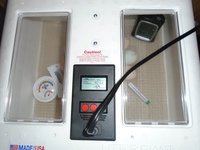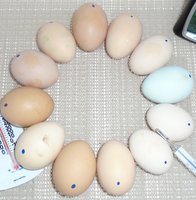Zinjifrah
Crowing
So, twice now I've incubated eggs. They were shipped Serama eggs, purchased off eBay. Both times, it ended up being a horrible hatch rate.
The first time, I received eighteen eggs. Six of those were viable by lock-down, after eight were removed as clears, one failed in early development, and three more failed before lock-down. Of those six, two failed after lock-down, fully developed without pipping, and four hatched. A twenty two percent hatch rate.
The second time, I received twenty two eggs. Thirteen were viable by lock-own, after removing one on day five that was stinking, one early fail, and seven clears. Ten of those thirteen failed after lock-down with full development and no pip. Three hatched. One of those three was from an egg half the size of the rest, and required assistance, but the chick is doing fine now. A fourteen percent hatch rate.
Given the results of those efforts, suffice to say that I was feeling very discouraged about hatching eggs. I decided to try local eggs, and see how much of the problem is in my incubation, and how much is in the eggs that I got, combined with shipping. I know in the second batch, the eggs arrived very dirty, and day five is very early for one to be so bad it stinks.
Enter one dozen local eggs, from the mixed flock of a lady who sells eggs for eating. The rooster is Cochin, the hens are Cochin, RIR, 'Ameracana' which I presume is actually an EE, unknown black (Probably Australorp) and unknown buff (Probably Orpington). My assumptions on the last two are just from what the feed stores commonly sell around here, since I did not see the birds myself. The eggs arrived on the fifth unwashed, but with only a few smudges on them to indicate that. I would call them clean eggs, of a variety of shapes, colors and sizes.

Here they are, on the fifth. The +/x marks the end with the air cell, the dash one side, the dot the other side for turning reference, and they are numbered to keep track of weights. They received no washing or other treatment before being put in the incubator. I can tell which one came from an EE! The rest I have no clue about. Number two looks kind of pink.
And there lies the next conundrum. For three days prior to getting the eggs, my incubator had been running like clockwork, just as it had through two batches of shipped eggs. Fifteen minutes before I left to meet the woman I bought the local eggs from, it was still holding perfect temperature and humidity was right where I wanted it, according to my thermometers and hygrometer. Right before I went out the door, I looked over and temperature was at eighty five degrees Fahrenheit. I got back, examined it, and discovered the heat had entirely failed.
So my experiment to check the incubator was a wash, because the incubator itself was dead! I briefly considered eating the eggs I'd just bought. They do look delicious, even though I don't actually like eggs as food.
Instead, I called around to every feed and hardware store within a four hour drive, and found the only incubator that was available. A 'Little Giant #9300' still air styrofoam contraption with no egg turner, that I have to lift the lid off of to turn the eggs by hand.

Suffice to say I really, really miss my cabinet style incubator. I gave the incubator one day to get up and running, then set the eggs into it. Given the fact that it's still air, and I'm only incubating a dozen eggs, I arranged them in a circle on some shelf liner on top of the included plastic mesh floor, below where the heat source is, for even heat distribution.

The various thermometers all have their own readings, which I've written down the adjustments for to know what the temperature actually is. The hygrometers, as well. The round hygrometer actually reads accurately for humidity, but I have no idea what it does for heat, since that reading never makes any sense on it. I don't use it for heat readings.
Egg weight as of the fifth, before setting: #1: 56g, #2: 63g, #3: 68g, #4: 69g, #5: 69g, #6: 67g, #7: 59g, #8: 59g, #9: 54g, #10: 47g, #11: 48g, # 12: 65g.
So huge, compared to the Serama eggs.
In the first five days of incubation, my heat was up and down with constant tweaking to try and get it to a stable temperature that I was content with, given my lack of familiarity with the incubator. Given that, my expectations for survival and life in the eggs has been fairly low. Today marks day five of incubation, and last night I candled, just to see if there was any point in continuing to try with them.
As of the end of day four, the tenth, fertility is one hundred percent, with veins visible in all eggs, even the darkest. Oddly, the blue egg is the hardest to see through.
That was a bit of a relief, considering the problems I've had settling the incubator in, when compared to the results with shipped eggs. The thermometers and hygrometers are the same that I was using in the previous incubator, though one of the hygrometers had gotten about 3% off when I calibrated prior to starting incubation. That was corrected. I eventually plan on replacing all with thermo-hygrometers that I can manually set, rather than needing a spreadsheet of variances!
Currently, my temperatures are holding right above one hundred degrees Fahrenheit at the tops of the eggs, and just above ninety-nine degrees Fahrenheit at the bottoms of the eggs. The eggs are turned every four hours during the day, at eight a.m., noon, four p.m., eight p.m., and midnight. I decided to sleep instead of turning them at four a.m. They are turned in place once, then on the next turning I flip ends to alternate the air pocket to the inside or outside of the circle, since the highest heat level is in the middle.
Overall, much more work than my forced-air cabinet incubator, and the temperatures are neither as stable nor as even. On day ten, the sixteenth, I will be candling to see how many remain viable and weighing those that are. Lock-down is on day eighteen, which is the twenty-fourth, when I will weigh them again, and hatch day is anticipated to be the twenty-seventh.
Primarily, I'm incubating these eggs to find out how effective my incubation methods are, considering the trouble I've had hatching shipped Serama eggs. After I see what the hatch rate is for these eggs, I'll try another batch shipped. I have already made arrangements to purchase some Lavender Ameraucana bantam hatching eggs from a breeder contacted via the ABC breeder directory, for incubation next month. Hopefully, from this, I'll find out not only if my incubation is effective, but get an idea of how much different shipped eggs from a club breeder are compared to those purchased off eBay.
I really like my little Seramas, regardless of the trouble I've had trying to get them. Unfortunately, I'm looking at a high probability that of the seven chicks I have managed to hatch, six of them are cockerels, with all three of the newer chicks showing ruddy wattles, one of whome started trying to crow at only six days old. One poor, lone little pullet, from the first batch of eggs... who is also the only silkied. I am very much hoping I'll eventually be hatching some more Seramas.
Incidentally, anyone who actually made it to the end of this post deserves a shiny gold star.

You can all share. I only have one star.
The first time, I received eighteen eggs. Six of those were viable by lock-down, after eight were removed as clears, one failed in early development, and three more failed before lock-down. Of those six, two failed after lock-down, fully developed without pipping, and four hatched. A twenty two percent hatch rate.
The second time, I received twenty two eggs. Thirteen were viable by lock-own, after removing one on day five that was stinking, one early fail, and seven clears. Ten of those thirteen failed after lock-down with full development and no pip. Three hatched. One of those three was from an egg half the size of the rest, and required assistance, but the chick is doing fine now. A fourteen percent hatch rate.
Given the results of those efforts, suffice to say that I was feeling very discouraged about hatching eggs. I decided to try local eggs, and see how much of the problem is in my incubation, and how much is in the eggs that I got, combined with shipping. I know in the second batch, the eggs arrived very dirty, and day five is very early for one to be so bad it stinks.
Enter one dozen local eggs, from the mixed flock of a lady who sells eggs for eating. The rooster is Cochin, the hens are Cochin, RIR, 'Ameracana' which I presume is actually an EE, unknown black (Probably Australorp) and unknown buff (Probably Orpington). My assumptions on the last two are just from what the feed stores commonly sell around here, since I did not see the birds myself. The eggs arrived on the fifth unwashed, but with only a few smudges on them to indicate that. I would call them clean eggs, of a variety of shapes, colors and sizes.

Here they are, on the fifth. The +/x marks the end with the air cell, the dash one side, the dot the other side for turning reference, and they are numbered to keep track of weights. They received no washing or other treatment before being put in the incubator. I can tell which one came from an EE! The rest I have no clue about. Number two looks kind of pink.
And there lies the next conundrum. For three days prior to getting the eggs, my incubator had been running like clockwork, just as it had through two batches of shipped eggs. Fifteen minutes before I left to meet the woman I bought the local eggs from, it was still holding perfect temperature and humidity was right where I wanted it, according to my thermometers and hygrometer. Right before I went out the door, I looked over and temperature was at eighty five degrees Fahrenheit. I got back, examined it, and discovered the heat had entirely failed.
So my experiment to check the incubator was a wash, because the incubator itself was dead! I briefly considered eating the eggs I'd just bought. They do look delicious, even though I don't actually like eggs as food.
Instead, I called around to every feed and hardware store within a four hour drive, and found the only incubator that was available. A 'Little Giant #9300' still air styrofoam contraption with no egg turner, that I have to lift the lid off of to turn the eggs by hand.

Suffice to say I really, really miss my cabinet style incubator. I gave the incubator one day to get up and running, then set the eggs into it. Given the fact that it's still air, and I'm only incubating a dozen eggs, I arranged them in a circle on some shelf liner on top of the included plastic mesh floor, below where the heat source is, for even heat distribution.

The various thermometers all have their own readings, which I've written down the adjustments for to know what the temperature actually is. The hygrometers, as well. The round hygrometer actually reads accurately for humidity, but I have no idea what it does for heat, since that reading never makes any sense on it. I don't use it for heat readings.
Egg weight as of the fifth, before setting: #1: 56g, #2: 63g, #3: 68g, #4: 69g, #5: 69g, #6: 67g, #7: 59g, #8: 59g, #9: 54g, #10: 47g, #11: 48g, # 12: 65g.
So huge, compared to the Serama eggs.
In the first five days of incubation, my heat was up and down with constant tweaking to try and get it to a stable temperature that I was content with, given my lack of familiarity with the incubator. Given that, my expectations for survival and life in the eggs has been fairly low. Today marks day five of incubation, and last night I candled, just to see if there was any point in continuing to try with them.
As of the end of day four, the tenth, fertility is one hundred percent, with veins visible in all eggs, even the darkest. Oddly, the blue egg is the hardest to see through.
That was a bit of a relief, considering the problems I've had settling the incubator in, when compared to the results with shipped eggs. The thermometers and hygrometers are the same that I was using in the previous incubator, though one of the hygrometers had gotten about 3% off when I calibrated prior to starting incubation. That was corrected. I eventually plan on replacing all with thermo-hygrometers that I can manually set, rather than needing a spreadsheet of variances!
Currently, my temperatures are holding right above one hundred degrees Fahrenheit at the tops of the eggs, and just above ninety-nine degrees Fahrenheit at the bottoms of the eggs. The eggs are turned every four hours during the day, at eight a.m., noon, four p.m., eight p.m., and midnight. I decided to sleep instead of turning them at four a.m. They are turned in place once, then on the next turning I flip ends to alternate the air pocket to the inside or outside of the circle, since the highest heat level is in the middle.
Overall, much more work than my forced-air cabinet incubator, and the temperatures are neither as stable nor as even. On day ten, the sixteenth, I will be candling to see how many remain viable and weighing those that are. Lock-down is on day eighteen, which is the twenty-fourth, when I will weigh them again, and hatch day is anticipated to be the twenty-seventh.
Primarily, I'm incubating these eggs to find out how effective my incubation methods are, considering the trouble I've had hatching shipped Serama eggs. After I see what the hatch rate is for these eggs, I'll try another batch shipped. I have already made arrangements to purchase some Lavender Ameraucana bantam hatching eggs from a breeder contacted via the ABC breeder directory, for incubation next month. Hopefully, from this, I'll find out not only if my incubation is effective, but get an idea of how much different shipped eggs from a club breeder are compared to those purchased off eBay.
I really like my little Seramas, regardless of the trouble I've had trying to get them. Unfortunately, I'm looking at a high probability that of the seven chicks I have managed to hatch, six of them are cockerels, with all three of the newer chicks showing ruddy wattles, one of whome started trying to crow at only six days old. One poor, lone little pullet, from the first batch of eggs... who is also the only silkied. I am very much hoping I'll eventually be hatching some more Seramas.
Incidentally, anyone who actually made it to the end of this post deserves a shiny gold star.

You can all share. I only have one star.

